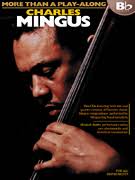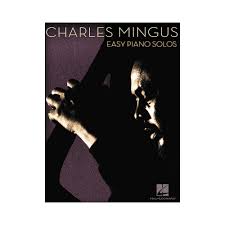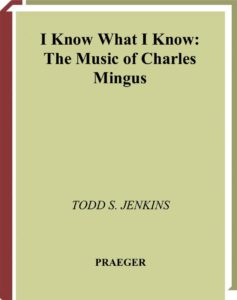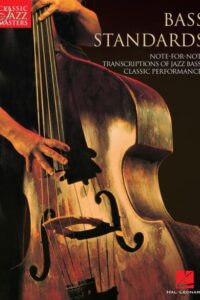Come join us now, and enjoy playing your beloved music and browse through great scores of every level and styles!
Can’t find the songbook you’re looking for? Please, email us at: sheetmusiclibrarypdf@gmail.com We’d like to help you!
Table of Contents

Best Sheet Music download from our Library.
Please, subscribe to our Library.
If you are already a subscriber, please, check our NEW SCORES’ page every month for new sheet music. THANK YOU!
Charles Mingus: The Angry Man of Jazz
Introduction

Charles Mingus (1922–1979) was one of the most innovative and influential figures in jazz history. A virtuoso bassist, accomplished pianist, brilliant composer, and fiery bandleader, Mingus pushed the boundaries of jazz, blending elements of bebop, blues, classical music, gospel, and avant-garde into a singular, explosive style. His music was deeply emotional, often politically charged, and always unpredictable.
Beyond his musical genius, Mingus was known for his fiery temperament, earning him the nickname “The Angry Man of Jazz.” Yet, beneath his volatile exterior was a man deeply committed to artistic integrity, racial equality, and the evolution of jazz as a high art form.
This article explores Mingus’ life, musical style, key influences, legacy, essential works, film appearances, discography, and links to some of his greatest compositions.

Biography:
Early Life (1922–1940s)
Charles Mingus Jr. was born on April 22, 1922, in Nogales, Arizona, but grew up in the Watts neighborhood of Los Angeles. His early exposure to music came from the church—his stepmother’s Holiness congregation introduced him to gospel—and from classical music, which he studied on the cello before switching to the double bass.
As a teenager, Mingus absorbed the sounds of Duke Ellington, Jelly Roll Morton, and Art Tatum. He began playing bass professionally in his late teens, working with jazz and swing bands, including Louis Armstrong’s group in the early 1940s.

Rise to Prominence (1950s)
In the 1950s, Mingus moved to New York, where he became a key figure in the bebop movement. He played with legends like Charlie Parker, Dizzy Gillespie, and Bud Powell, while also developing his own voice as a composer.
In 1953, he co-founded Debut Records with drummer Max Roach, releasing early recordings that showcased his ambitious compositions. However, it was his work with his own groups—particularly his Jazz Workshop ensembles—that cemented his reputation as a visionary.
Peak Creativity (1960s–1970s)

The 1960s were Mingus’ most prolific period. Albums like The Black Saint and the Sinner Lady (1963) and Mingus Ah Um (1959) displayed his mastery of large-scale composition, blending jazz with classical structures.
Mingus was also politically outspoken, addressing racial injustice in works like “Fables of Faubus” (a protest against Arkansas governor Orval Faubus, who resisted school desegregation).
By the late 1960s, financial struggles and health issues slowed his output, but he experienced a resurgence in the 1970s, collaborating with younger musicians and even working with Joni Mitchell on her Mingus-inspired album.
Final Years & Death (1979)
Mingus was diagnosed with ALS (Lou Gehrig’s disease) in the late 1970s, which gradually robbed him of his ability to play. He died on January 5, 1979, in Cuernavaca, Mexico, at age 56. Despite his physical decline, he continued composing until the end, dictating music to assistants.
Musical Style & Innovations
Mingus’ music defied easy categorization. He drew from:
- Bebop – Complex harmonies and rapid improvisation.
- Blues & Gospel – Raw emotional expression and call-and-response structures.
- Third Stream – Fusion of jazz and classical (influenced by composers like Stravinsky and Bartók).
- Avant-Garde Jazz – Free-form improvisation and unconventional structures.
Key Characteristics of His Music:
- Emotional Intensity – Mingus’ compositions could shift from tender lyricism to explosive rage.
- Collective Improvisation – Unlike rigid bebop, Mingus encouraged his musicians to interact dynamically.
- Political & Autobiographical Themes – Many works reflected his views on racism, love, and struggle.
- Orchestral Jazz – He often wrote for larger ensembles, blending jazz with classical forms.

Influences

Mingus was shaped by a wide range of artists:
- Duke Ellington – His biggest idol; Mingus’ large-ensemble writing owes much to Ellington.
- Charlie Parker – Inspired his bebop phrasing.
- Classical Composers (Stravinsky, Ravel, Bach) – Influenced his structural complexity.
- Gospel & Blues (Mahalia Jackson, Lead Belly) – Gave his music its raw emotional power.
Legacy
Mingus left an indelible mark on jazz and beyond:
- Jazz Education – His compositions are now jazz standards, studied worldwide.
- Influence on Later Artists – Musicians like Jaco Pastorius, Wynton Marsalis, and even rock artists (Frank Zappa, Joni Mitchell) cite him as an inspiration.
- The Mingus Big Band – Founded after his death, it keeps his music alive.
- Posthumous Honors – A Grammy Lifetime Achievement Award (1997) and a postage stamp in his honor (1995).
Essential Works:

Studio Albums
- Mingus Ah Um (1959) – Features classics like “Goodbye Pork Pie Hat” (a tribute to Lester Young).
- The Black Saint and the Sinner Lady (1963) – A six-movement suite, one of jazz’s greatest masterpieces.
- Mingus Mingus Mingus Mingus Mingus (1963) – Revisits earlier works with expanded arrangements.
- Let My Children Hear Music (1971) – A late-career orchestral triumph.
Live Albums
- Mingus at Antibes (1960) – A fiery live set with Eric Dolphy.
- Cornell 1964 – A recently discovered gem showcasing his quintet at its peak.
Notable Compositions
- “Moanin’” – A bluesy, hard-swinging anthem.
- “Haitian Fight Song” – A politically charged, explosive piece.
- “Pithecanthropus Erectus” – A musical depiction of human evolution.
- “Fables of Faubus” – A satirical protest against racism.
Filmography
Though primarily a musician, Mingus appeared in:
- Shadows (1959) – Improvised soundtrack for John Cassavetes’ film.
- Mingus: Charlie Mingus 1968 – A documentary on his life and struggles.
- Triumph of the Underdog (1998) – A posthumous documentary.
Discography (Selected)
| Year | Album | Label |
|---|---|---|
| 1956 | Pithecanthropus Erectus | Atlantic |
| 1959 | Mingus Ah Um | Columbia |
| 1959 | Blues & Roots | Atlantic |
| 1960 | Mingus at Antibes | Atlantic |
| 1963 | The Black Saint and the Sinner Lady | Impulse! |
| 1964 | Mingus Mingus Mingus Mingus Mingus | Impulse! |
| 1971 | Let My Children Hear Music | Columbia |
Videos of Key Compositions
- Moanin’ (1959) – A defining Mingus blues.
- Goodbye Pork Pie Hat (1959) – A haunting tribute to Lester Young.
- Haitian Fight Song (1957) – A fierce political statement.
- The Black Saint and the Sinner Lady (Full Album) – A symphonic jazz masterpiece.
Conclusion
Charles Mingus was a titan of jazz—a man whose music was as complex and passionate as his personality. His compositions remain timeless, his bass playing revolutionary, and his influence immeasurable. From the fiery protest of “Fables of Faubus” to the orchestral grandeur of The Black Saint and the Sinner Lady, Mingus’ work continues to inspire musicians and listeners alike.
As he once said:
“Making the simple complicated is commonplace; making the complicated simple, awesomely simple, that’s creativity.”
And in that, Mingus was a true creative genius.
